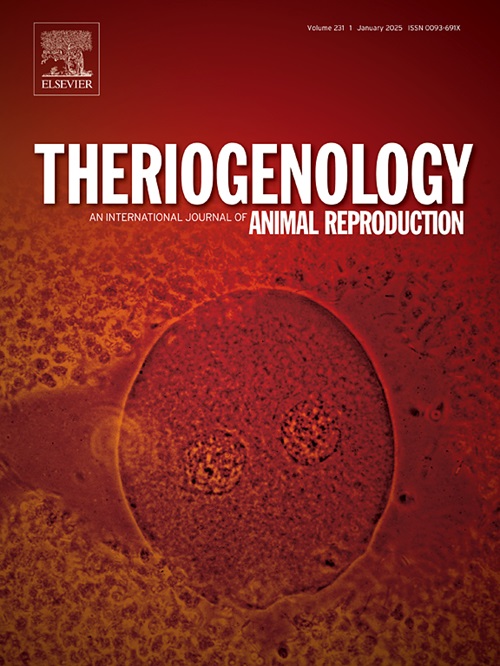犬短头性阻塞性气道综合征影响妊娠期间呼吸和血液动力学生理适应
IF 2.4
2区 农林科学
Q3 REPRODUCTIVE BIOLOGY
引用次数: 0
摘要
短头性阻塞性气道综合征(BOAS)对动物福利和生活质量产生负面影响,伴有令人不安的呼吸窘迫症状以及临床和生殖问题。因此,本研究的目的是比较有或没有短头性阻塞性气道综合征症状的母狗在妊娠不同阶段的呼吸模式、子宫血流动力学特征和胎盘发育。根据母狗繁育前BOAS的症状表现分为短头综合征组(n = 10)和非短头综合征(对照组)组(n = 10)。在妊娠早期、中期和晚期,对女性进行临床评估(心率和呼吸频率、体温、毛细血管再充血时间、水合作用和粘膜颜色评分、血压和外周血氧饱和度)、动脉血酸碱平衡、产科b型血、子宫动脉和脐动脉多普勒流速测定。BOAS母狗(P <;0.05),妊娠早期心率增高(P <;0.05)妊娠后期呼吸速率,直至妊娠中期出现酸血症倾向,碱过量(BE)和碳酸氢盐浓度较低,而co2分压保持不变。BOAS女性胎儿发育较慢(P <;妊娠期间胎盘生长和脐动脉血流改善,但子宫动脉血管化维持不变。综上所述,怀孕的BOAS母狗在怀孕期间呼吸模式和酸碱平衡发生了改变;然而,在不影响脐动脉血流动力学的情况下。胎儿胎盘单位内的适应足以满足生理妊娠需求,并部分支持胎儿的正常生长。本文章由计算机程序翻译,如有差异,请以英文原文为准。
Canine Brachycephalic Obstructive Airway Syndrome impacts respiratory and hemodynamic physiological adaptations during pregnancy
Brachycephalic obstructive airway syndrome (BOAS) has a negative impact on animal welfare and quality of life, with perturbing signs of respiratory distress and both clinical and reproductive issues. Therefore, the aim of this study was to compare the respiratory pattern, uterine hemodynamic profile, and placenta development during different stages of pregnancy in bitches with or without symptoms of the brachycephalic obstructive airway syndrome. Bitches were grouped according to the symptomatic manifestation of BOAS before breeding, as Brachycephalic Syndrome Group (n = 10) and Non-brachycephalic Syndrome (Control) Group (n = 10). Along gestation (early, mid and late stage), females were examined for clinical evaluations (heart and respiratory rates, body temperature, capillary refill time, hydration and mucosal color score, blood pressure and peripheral oxygen saturation), arterial blood acid-base balance and obstetric B-mode and uterine and umbilical artery dopplervelocimetry. BOAS bitches had higher (P < 0.05) early-pregnancy heart rate, and increased (P < 0.05) respiratory rate at late-pregnancy, tendency to acidemia and lower base excess (BE) and bicarbonate concentration until mid-pregnancy, while PCO2 remained unchanged. Fetus of BOAS females had slower (P < 0.05) placental growth and improvement of umbilical artery blood flow along gestation, although uterine artery vascularization remained unchanged. In conclusion, pregnant BOAS bitches have altered respiratory pattern and acid-base balance during pregnancy; however, without negatively impacting hemodynamics of the umbilical artery. Adaptations within the fetal-placental unit were sufficient to meet physiological pregnancy demands and partially support proper fetal growth.
求助全文
通过发布文献求助,成功后即可免费获取论文全文。
去求助
来源期刊

Theriogenology
农林科学-生殖生物学
CiteScore
5.50
自引率
14.30%
发文量
387
审稿时长
72 days
期刊介绍:
Theriogenology provides an international forum for researchers, clinicians, and industry professionals in animal reproductive biology. This acclaimed journal publishes articles on a wide range of topics in reproductive and developmental biology, of domestic mammal, avian, and aquatic species as well as wild species which are the object of veterinary care in research or conservation programs.
 求助内容:
求助内容: 应助结果提醒方式:
应助结果提醒方式:


